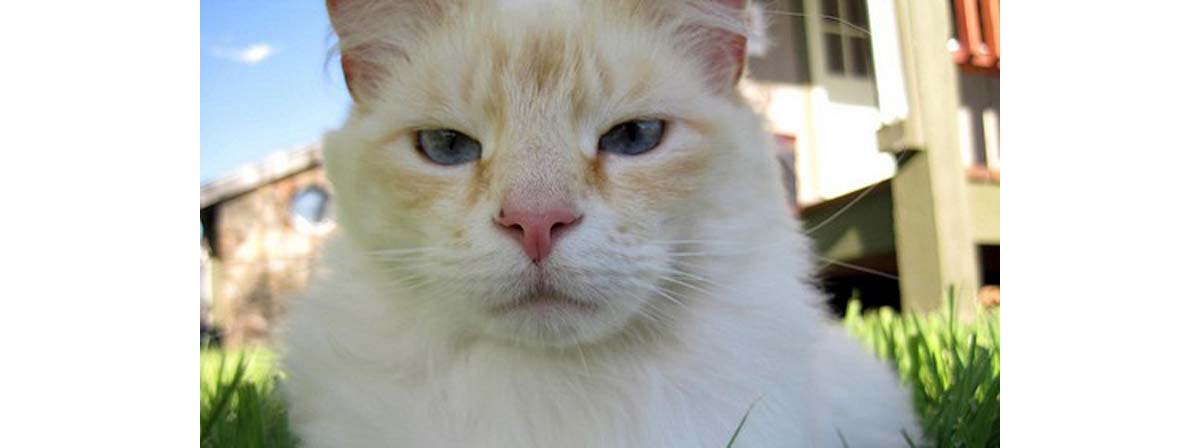Table of Contents
If you spend any time at all on the Internet — and the fact that you have found this article heavily suggests that you do — you will know that there is no type of photo that is more likely to go viral on Facebook than a classic kitty photo and no kind of video more likely to go viral on YouTube than of a kitty video. Why are cats so viral on social media? What makes them enjoyable to watch?

Well, the simple fact is that most people find cats to be fascinating, and for good reason. Whether it's watching a cat meowing in a strange way or a cat constantly knocking items onto the floor, it's entertaining to watch.
Humans love cats. We pet them. We groom them. We feed them Fancy Feast. We build them kitty climbing gyms and we talk to them in kitty talk. Americans alone spend over $15 billion per year on cat food and other products to make cats comfortable. Charities are organized to provide for stray cats. Kitty videos secure literally billions of views.
When you really think about it, it's all enough to make you wonder whether cats somehow have control over our minds. Surprisingly, one Czech scientist strongly believes that felines might actually have some control over our minds. How? Let's find out.
Ants, Cats, and Brain Control
Jaroslav Flegr is an extraordinarily productive biological researcher who is located in the Czech Republic. Because he has been focused on biology rather than on mastering the English language, he seldom attends conferences, and aside from a story in Atlantic Monthly a few years ago, relatively few people that live outside of Eastern Europe are aware of his intriguing work.
Flegr had read the work of the English evolutionary biologist Richard Dawkins, who described the ways in which a flatworm can enslave an ant by invading its nervous system. Instead of heading into its anthill when temperatures drop, the flatworm-infected ant climbs a blade of grass and bites it, hanging on until both grass and ant are consumed by a sheep. Once the ant is digested along with the blade of grass in the sheep's stomach, the flatworm is able to reproduce and release its offspring in the sheep's droppings.
The Czech biologist started to wonder if some kind of parasite might be doing something similar to him. Growing up in Czechoslovakia during the Communist era, he often made statements that could have landed him in trouble with the political authorities. He often wandered off into heavy traffic, he told Atlantic Monthly, with cars always honking at him. He was even caught in a gun battle during a visit to eastern Turkey, but Flegr said he was not worried at all about the circumstances, even though all of his fellow travelers were terrified. Flegr did not have a clue as to what could be wrong with him until in 1990 when he was appointed to do research at Charles University in Prague, where there happened to be a major research project on the parasite Toxoplasmodium gondii, which is also known as T. gondii.
A Parasite That Hides Out in the Human Brain
The toxoplasmosis parasite, it turns out, goes through a life cycle very similar to the flatworm described by Dr. Dawkins. T. gondii is only capable of reproducing when it is inside the small intestine of a cat. After mating, the parasites and their offspring are released into kitty poop, and have to find a new host.
Toxoplasmosis parasites can't reproduce in humans and other animals. However, this banana-shaped single-celled microorganism is capable to slipping out of the kitty litter and into the tissues of warm-blooded animals, this can also include humans who change litter boxes, to find the perfect place to "hang out" until it is eventually eaten by a cat so it can mate with another T. gondii to reproduce. That perfect hang out for the parasite is the brain.
The Toxoplasmosis gondii parasite finds its way into brain tissue and encases itself in a cyst, waiting for the opportunity to be eaten by a cat so it can reproduce. As a cyst, the parasite can survive for many years in a not-quite dormant state, active only to the extent, Flegr found, of influencing its host's behavior so that the host's brain is eaten by a cat. The effects of the parasite turn out to be quite specific.
- Fond G, Capdevielle D, Macgregor A, Attal J, Larue A, Brittner M, Ducasse D, Boulenger JP. [Toxoplasma gondii: a potential role in the genesis of psychiatric disorders].Encephale. 2013 Feb
- 39(1):38-43. doi: 10.1016/j.encep.2012.06.014. Epub 2012 Aug 21. French.
- McAuliffe, K. How Your Cat Is Making You Crazy. Atlantic Monthly. March 2012.
- Photo courtesy of Wayne Noffsinger by Flickr : www.flickr.com/photos/knottyboywayne/5837477958/
- Photo courtesy of MartialArtsNomad.com by Flickr : www.flickr.com/photos/superwebdeveloper/4887123507/


Your thoughts on this